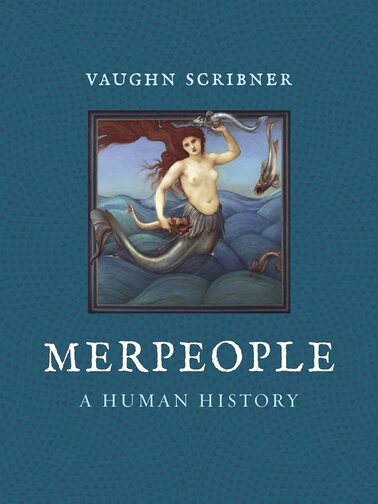
TITLE: Merpeople: A Human History
AUTHOR: Vaughn Scribner
PUBLISHER: Reaktion Books
ISBN: 9781789143140
PODCAST EPISODE: None
REVIEWER: Mark Norman
At just over 300 pages, Merpeople is a standard sized book with a far from average remit - taking in as it does some one thousand years of history and examining the representations of merfolk across that time, along with the shifting cultural meaning throughout that period.
The author is an Assistant Professor of History at the University of Central Arkansas, so you should expect (and will find) plenty of academic rigour, but without the dry approach which you might think would accompany it. Scribner is writing for a general market here, not for his peers, and hence the book is easy to read, accessible and at the same time full of historic interpretation and definition of the motif of the merpeople.
After a full introduction which lays out exactly what to expect from the book, the first chapter begins in the medieval, examining the interplay between the merfolk and the Church. Part of this investigation naturally looks earlier, discussing how the Christian Church shaped earlier ideas surrounding the merfolk to its own ends. We see the mythological roots exposed here, illustrated with plenty of examples from the illuminated manuscripts and church carvings of the time.
The following two chapters move through the historical periods, taking us through to the height of the popularity of the circus, with an in-depth look at the appearances of merpeople in carnivals, freakshows and other attractions. From medically-afflicted humans to crude but popular hoaxes, the public would clamour at this time to see such 'wonders'. Scribner discusses the role and legacy of major players such as PT Barnum, as well as looking at art and literature in the same period.
Chapter Five takes the book into the modern period with an examination of film and television portrayals of mermaids (usually) and mermen (sometimes). The final chapter, before the book draws its conclusions, moves away from the Western portrayals to compare and contrast these with merpeople across the rest of the globe.
Merpeople is obviously meticulously researched and is well written and put-together. It is also, as is often the case from this publisher, a beautiful volume. The book is lavishly illustrated throughout in both colour and black-and-white, printed on a high-quality gloss paper and bound in a really solid and substantial hardback case. If the subject of merpeople holds any interest for you at all, you could not hope to learn more than from this title. This would be a perfect companion to take alongside Sophia Kingshill's feminist approach monograph 'Mermaids' for a deep dive (no pun intended) into this area of folklore.
AUTHOR: Vaughn Scribner
PUBLISHER: Reaktion Books
ISBN: 9781789143140
PODCAST EPISODE: None
REVIEWER: Mark Norman
At just over 300 pages, Merpeople is a standard sized book with a far from average remit - taking in as it does some one thousand years of history and examining the representations of merfolk across that time, along with the shifting cultural meaning throughout that period.
The author is an Assistant Professor of History at the University of Central Arkansas, so you should expect (and will find) plenty of academic rigour, but without the dry approach which you might think would accompany it. Scribner is writing for a general market here, not for his peers, and hence the book is easy to read, accessible and at the same time full of historic interpretation and definition of the motif of the merpeople.
After a full introduction which lays out exactly what to expect from the book, the first chapter begins in the medieval, examining the interplay between the merfolk and the Church. Part of this investigation naturally looks earlier, discussing how the Christian Church shaped earlier ideas surrounding the merfolk to its own ends. We see the mythological roots exposed here, illustrated with plenty of examples from the illuminated manuscripts and church carvings of the time.
The following two chapters move through the historical periods, taking us through to the height of the popularity of the circus, with an in-depth look at the appearances of merpeople in carnivals, freakshows and other attractions. From medically-afflicted humans to crude but popular hoaxes, the public would clamour at this time to see such 'wonders'. Scribner discusses the role and legacy of major players such as PT Barnum, as well as looking at art and literature in the same period.
Chapter Five takes the book into the modern period with an examination of film and television portrayals of mermaids (usually) and mermen (sometimes). The final chapter, before the book draws its conclusions, moves away from the Western portrayals to compare and contrast these with merpeople across the rest of the globe.
Merpeople is obviously meticulously researched and is well written and put-together. It is also, as is often the case from this publisher, a beautiful volume. The book is lavishly illustrated throughout in both colour and black-and-white, printed on a high-quality gloss paper and bound in a really solid and substantial hardback case. If the subject of merpeople holds any interest for you at all, you could not hope to learn more than from this title. This would be a perfect companion to take alongside Sophia Kingshill's feminist approach monograph 'Mermaids' for a deep dive (no pun intended) into this area of folklore.